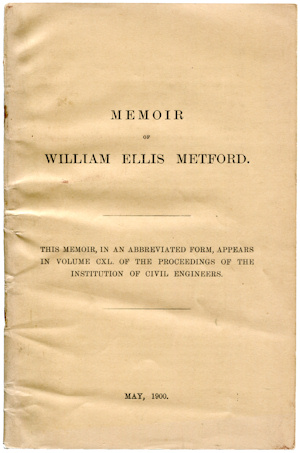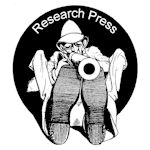This Memoir was privately printed in May, 1900. It was written by W.E. Metford's friend and contemporary Henry Brunel, C.E. and Major the Hon. T.F. Fremantle (later Lord Cottesloe).
Metford's work, whether in India or at home, was worthy of wider appreciation than it received, and he left in the world of those interested in rifle-work a gap which there is none to fill.
 WILLIAM ELLIS METFORD, was the elder son of William Metford, M.D., of Flook House, Taunton, by his marriage with Miss M. E. Anderdon, and was born on Oct. 4th, 1824.
WILLIAM ELLIS METFORD, was the elder son of William Metford, M.D., of Flook House, Taunton, by his marriage with Miss M. E. Anderdon, and was born on Oct. 4th, 1824.
The family of Metford is an old one in the West Country - a Metford was Bishop of Salisbury in 1396 - and Metford's grandfather, Dr. Ellis Button Metford, who owned Post Green House, Poole, as well as Flook House, was a widely known physician with a large practice, and a man both able and agreeable. Metford's father ceased to practice when quite a young man, on his marriage in 1821, and devoted himself to country pursuits, being a good sportsman, an exceptionally skilful archer, and a very good shot with the rifle. He assisted his friend and neighbour, Mr. Andrew Crosse, of Broomfield Hall in many electrical experiments, one of which was to obtain powerful discharges from lightning by means of a very long circuit of wires set up in the open fields. Mr. Metford's elder sister married Mr. R. G. Badcock, of Taunton; his younger brother, Lawrence G. Metford, entered the 6th Regiment, but when aged only 21 went down in the "Birkenhead " on the way to the Kaffir War off Point Danger in Simon's Bay, Cape Province, South Africa, February 26, 1852, with 488 men standing at attention.
Mr. Metford was sent to school at Sherborne from 1838 to 1841, under Dr. Lyon, but seems to have shown no remarkable aptitude for study. He is remembered by his contemporaries as an agreeable and very intelligent boy, very kind to his juniors, and even then, fond of a. talk about rifle shooting. His interest in firearms had considerable scope when he was at home, for his father had established a rifle club with a range in the fields at Flook House. He also developed a taste for mechanics, his father having a small workshop, and during his holidays he made, among other things, a model steam-engine, for which he had first to make many of his own tools. This, no doubt, was the first step to the adoption of engineering as his profession, for which the development of railways, then in active progress in his neighbourhood, gave every opportunity.
He was apprenticed first to Mr. W. M. Peniston, resident engineer under Mr. Brunel, on the Bristol and Exeter Railway, and was afterwards employed, from 1846 to 1850, on the Wilts, Somerset and Weymouth Railway. At this time his chief hobby was the making of rockets and other fireworks, and while lodging at Frampton (Dorset), at the house of a gamekeeper, he narrowly escaped severe injury from the accidental combustion of some of his materials in his sitting room. He devised an ingenious double rocket, a second charge in which was ignited as the first burnt out.
After 1850 the work on the Wilts, Somerset and Dorset ceased, and Mr. Metford, applied for the appointment of Surveyor to the City of Bristol, having a very high testimonial from Mr. Brunel, but he did not obtain this appointment. Afterwards he was employed in levelling and surveying by Mr. T. E. Blackwell, C.E., engineer of the Bristol Docks, in connection with schemes for the development of the traffic of that town.
In November, 1854 he was recommended for the situation of resident engineer of the Bristol and Exeter Railway, by Mr. Brunel, but was not appointed. He afterwards acted for a short time on the Wycombe Railway as engineer under Mr. Peniston, who had then become contractor. In connection with this work he resided for a time at Bourne End.
Early in 1855 he was introduced by his friend, Mr. G. B. Pennell, to the late Mr. William Froude, who at once recognised his worth and the skill and accuracy of his workmanship as something out of the common. The intimate friendship thus begun continued until Mr. Froude's death in 1879. At the time of this introduction, Mr. Metford had devised a little contrivance with which he could pick any Bramah lock - a feat which created much astonishment. Some years earlier he had designed an improved Theodolite - made under his instructions by King, of Bristol. The chief features of it were a traversing stage, giving a movement of one inch in any direction, and a curved arm upholding the transit axis, which made it both light and very convenient in use.
He also invented a special and very good form of level. His design was that the upright stem of the level telescope should terminate in a sphere which was to be gripped by a ring grip held by four screws pulling downwards, and this sphere was to rest on the lower plate of the level. The great increase of friction of the ring grip over the mere downward pressure would and did control the friction on the lower plate. The advantage of this plan was that the legs of the instrument could be fixed, very firmly into the ground at any reasonable position, even if the plates were 25 degrees out of the horizontal. The pulling screws had spherical nuts, and the instrument could be set up anyhow, but still was capable of perfectly accurate adjustment. Mr. Froude then suggested that instead of a sphere resting on the bottom plate, there should be a hemisphere with an internal hollow hemisphere concentric with the outer one, and resting on a small sphere attached on top of the lower plate.
In March, 1856, Mr. Metford was elected an Associate of the Institution of Civil Engineers, being proposed by Mr. Brunel, while he received distinguished support from Messrs. J. M. Rendel, James Simpson, C. H.. Gregory, Wm. Gravatt, W. Froude, W. Pole and other eminent men of that day.
It will be more convenient to postpone, for the moment, mention of the important work which Mr. Metford was doing as regards rifles during these years, since the history of his experiment and improvements is really a continuous one. But the subject never ceased to occupy his attention, and the years 1852-1857 saw much useful work accomplished.
- Prev
- Next >>
